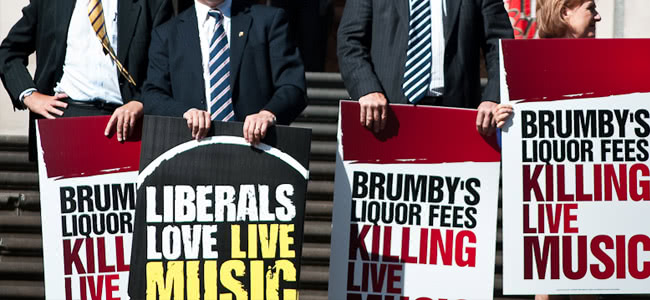It’s been a long time since the iconic SLAM Rally which saw 20,000 people march through Melbourne in protest of restrictive laws which linked music with violence and financially penalised live music venues. The unprecedented backlash forced the then Labor Government to capitulate on the issue resulting in a range of changes to existing laws and a new funding for organisations to better foster the live music scene in Victoria.
Now three years later, Melbourne’s music scene is fighting another battle – encroaching high rise residential developments that are concentrating in and around activity centres, bringing residents closer to established entertainment precincts and live music venues.
It’s an issue that has been bubbling for some time. In fact, it was the driving force behind Fair Go 4 Live Music back in 2003, who were fighting the gentrification of Melbourne’s inner-north and the inevitable noise complaints that followed forcing many live music venues and pubs out of the area.
It’s hard to believe that 10 years later the local music community, which contributes so much to the culture of Melbourne, is still dealing with this issue. Even our most iconic and much loved music venues are facing very real and present danger.
Venues including The Old Bar in Fitzroy, Pure Pop Records in St Kilda, The Prince Public Bar In St Kilda, Portsea Hotel in Portsea, Wesley Anne in Northcote, and The Empress in North Fitzroy have all battled noise complaints in recent years. The Birmingham Hotel in Fitzroy was left severely wounded after incessant noise complaints before eventually shutting down.
Now The Corner Hotel in Richmond and Cherry Bar on AC/DC lane in the city are both gearing up for a looming battle with high rise residential developments going up in uncomfortably close proximity to their front doors. Once completed, a horde of residents usually follows and we can expect that the noise complaints won’t be far behind.
You see, the system is backwards.[Soundproofing costs are] crippling for a small venue like Cherry Bar, and if a venue on AC/DC lane isn’t safe, then no one is safe.
Despite Fair Go 4 Live Music’s vigorous campaign to keep music in areas that saw big influxes of new residents, the agent of change principle has yet to be officially adopted by any of the inner-city councils in Melbourne.
The agent of change principle is the idea that the party who changes the status quo is the one responsible for dealing with any problems that arise, a principle that applies both ways.
For the resident, this implies a continued protection of amenity in the event of a change in venue operation or the development of a new music venue.
Conversely for the venue operator, this implies that where a venue is currently compliant with relevant noise attenuation standards and its operation does not change, new residential or other noise sensitive development should not lead to new compliance costs.
The onus of responsibility for the cost of noise management should fall upon the agent of change.
For example, if apartments are built next to an existing music venue, the owners are responsible for additional sound proofing, rather than the venue having to outlay huge expenses to retrofit further soundproofing because somebody decided they wanted to live next to a music venue but not hear any of the noise.
It makes sense. It’s fair to the venue, it’s fair to the resident. But it isn’t the law of the land, at least not yet.Live music institutions are now facing huge capital expenses to combat high-density residential developments.
The existing state policy we are instead faced with provides for the separation of existing land uses as the primary means of controlling the adverse amenity impacts of noise emissions. Some still maintain that creating cultural clusters will solve this problem. It won’t. It also doesn’t address the underlying issue.
Our successive planning ministers from both parties have been all too willing to sell our cultural institutions up the river in favour of big developers who have been allowed into areas that were traditionally off-limits. With the current political climate, no area is safe.
There’s a number of theories about what has motivated this shift in the attitude of developers and politicians alike, but a combination of political donations and poor transport infrastructure planning probably have something to do with it.
Regardless, live music institutions such as Cherry Bar are now facing huge capital expenses to combat high-density residential developments being built literally at their doorstep. Cherry Bar owner James Young is preparing for the inevitable legal battles over noise, and has estimated it will cost $80,000 to re-soundproof Cherry Bar with new brick walls, double-glazed windows and vacuum-sealed entries, as the Melbourne Times Weekly reports.
That cost is crippling for a small venue like Cherry Bar, and if a venue on AC/DC lane isn’t safe, then no one is safe.
If we want to talk about amenity, why aren’t we asking why developments are being approved without a single thought given to the impact that development may have on the existing cultural amenity of the area?
It’s hard to believe, but we’ve been through all of this already. We have a pretty good solution that will help manage the impact of residents and music venues colliding. But it’s nearly been ten years now since then Victorian Minister for Arts and Minister for Planning, Mary Delahunty, appointed the Live Music Taskforce.
A decade since that very taskforce recommended to the Victorian Government that it adopt the agent of change principle. And yet still, nothing. Not a single council has officially adopted the policy.
The live music scene is a cultural asset. Melbourne has a world-class contemporary music culture that contributes both culturally and economically to the state. Nationally, contemporary live music contributes over $500 million in revenue to the economy each and every year; 30% of that revenue is generated in Victoria.
Live music venues are critical to the cultural infrastructure. They are places that nurture social development and interaction. Some venues have attained an iconic status to Melbourne and are worthy of individual recognition and protection. The emergence of new venues is also important, as is the retention of a critical mass of venues.
Despite all this, the only thanks the live music community has received is a decade of political paralysis by our policymakers. Meanwhile, it’s projected that an extra 30-40,000 new residents will be moving into the inner city in the next five years.
But much like the liquor licensing issues of 2009, we can’t just sit back and expect things to change. We have to demand it.
We have to remind the Liberal Party of that day in 2010 where they stood on the steps of Parliament House waving placards proclaiming how much they loved live music. Well if you really love it, why the fuck haven’t you done something about it?
We have to remind our councils that they exist to foster a local community, not destroy it. That they must promote, not prosecute, live music venues.We have to remind our councils that they exist to foster a local community, not destroy it. That they must promote, not prosecute, live music venues.
If we don’t do something about it now, our favourite music venues will slowly disappear, suffocating under regulatory red tape and legislation that prioritises residential growth, rather than cultural preservation.
Already, organisations such as SLAM and Music Victoria are working around the clock on these very issues. But they need your help to finally get the ongoing marginalisation of music venues put back on the agenda of local government.
Music Victoria’s funding isn’t guaranteed by the government, and if you’re passionate about this issue, you could do a lot worse than becoming a member to help keep up the good fight.
National SLAM Day is less than two weeks away. Musicians and lovers of live music will be turning out on Saturday 23rd February for over 200 gigs that support and celebrate Australia’s live music scene.
Attending one of those gigs is a good first step. But it’s only the beginning. You need to add your voice to the growing chorus demanding our politicians do something about this issue.
And if it takes another 20,000 of us marching down Swanston Street again to show them that we mean business, then so be it. Because the continued viability of the live music scene is dependant upon the number, range, distribution and effective functioning of live music venues.
It may be a long way to the top if you want to rock n roll, but it’s only a short walk up Bourke Street.

































